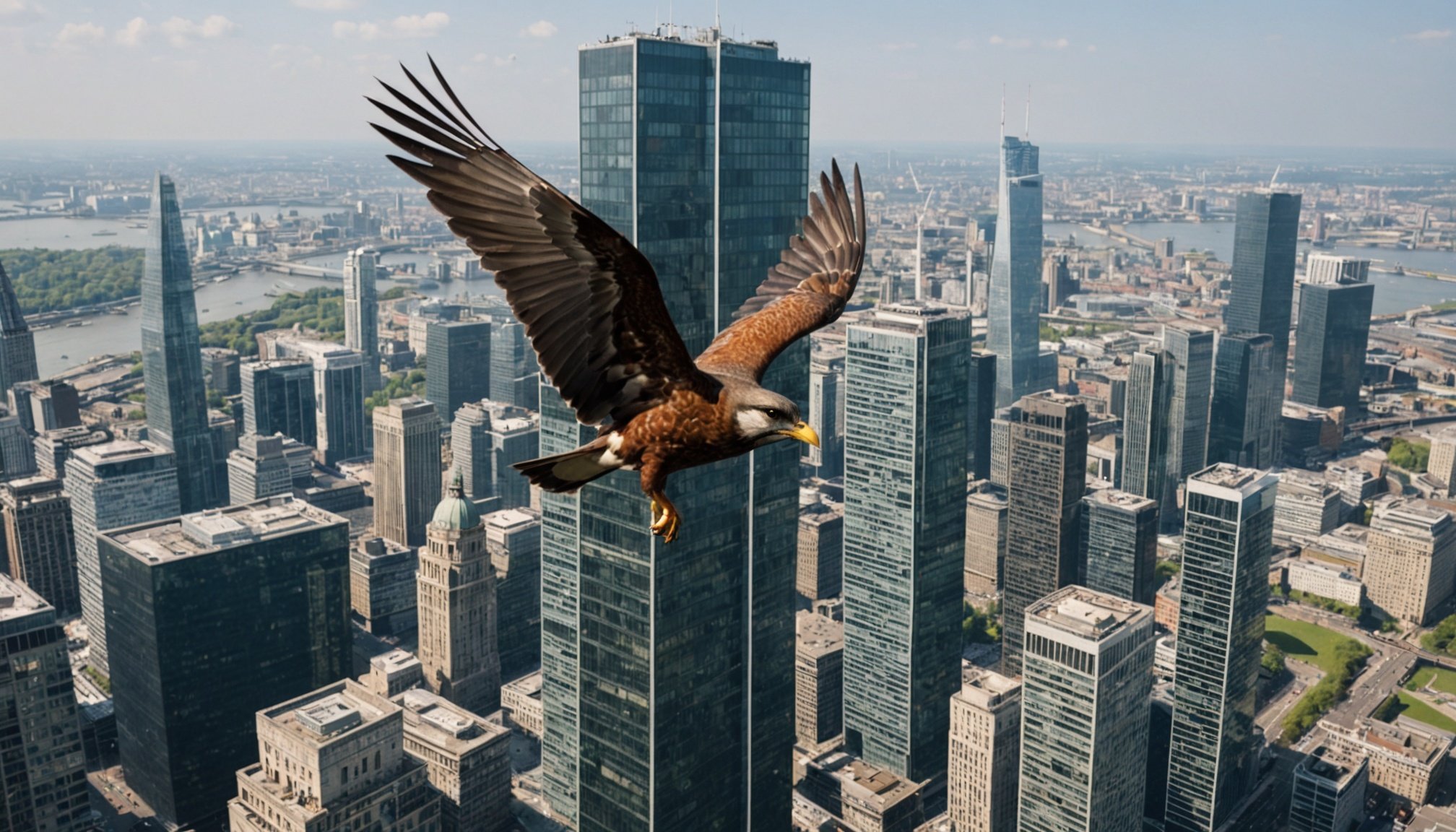Understanding Bird Strikes on Skyscrapers
Bird strikes on skyscrapers present a significant environmental challenge, particularly in densely populated urban environments. The impact extends beyond inconvenience, posing serious threats to bird populations. In the UK, these bird strikes are more common than one might think, involving a considerable number of birds every year. Statistics reveal alarming figures, with millions of birds suffering mortality annually due to collisions with tall buildings.
Birds often fail to see the transparent or reflective surfaces typically found on skyscrapers, mistaking them for open sky or places to fly through, leading to deadly impacts. This issue is not just about conservation but also maintaining the ecological balance within urban centers. Addressing bird safety isn’t merely an act of wildlife protection; it’s a crucial part of preserving biodiversity.
Also to see : Guardians of the sea: the uk”s innovative efforts to safeguard seabirds from plastic pollution
Efforts to mitigate skyscraper impact on birds focus on integrating bird safety into urban planning. Understanding bird strikes and their consequences helps foster strategies that protect wildlife. Engaging with architecture through bird-safe designs and community awareness campaigns ensures a holistic approach to solving this interspecies conflict. Practical conservation measures could be transformative in reducing these unfortunate incidents.
Effective Architectural Designs
Architectural solutions play an essential role in reducing bird strikes on skyscrapers. Innovative design features have shown promising results in mitigating these occurrences. Bird-friendly glass and reflective materials are at the forefront of such strategies. These materials visually signal to birds, preventing deadly collisions by making buildings more visible. Moreover, patterns on glass, whether etched or applied as films, help birds identify surfaces they shouldn’t fly towards, reducing the risk of impacts significantly.
Topic to read : Ultimate nutrition guide for uk pet owners: caring for rescued hedgehogs to promote their best health
Successful implementations across UK skyscrapers exhibit the practicality of these design strategies. For instance, the Ornilux glass technology incorporates a UV reflective coating that’s visible to birds but almost invisible to humans, effectively redirecting their flight paths.
Case studies reinforce the importance of integrating these architectural elements during the planning stage. Buildings such as the One Angel Square in Manchester exemplify sustainable and bird-safe designs, setting a standard for future urban constructions.
By continuously developing and adopting bird-safe buildings, the architectural sector showcases its commitment to conservation. These strategic interventions are not only pivotal in lessening bird mortality but also embody a broader commitment to ecological responsibility and sustainable urban development.
Technological Solutions to Minimize Bird Strikes
Technological solutions play a significant role in enhancing bird safety around skyscrapers. Various monitoring systems are employed to detect and deter birds, effectively reducing collision risks. For example, bird detection systems use radar and sensors to track bird movements near buildings, triggering alerts that modify lighting or emit sounds to redirect flight paths. This proactive approach allows for real-time intervention, significantly minimising bird strikes.
One effective deterrent method involves using acoustic signals that alter bird flight behaviour, guiding them away from hazardous areas. These auditory cues are non-intrusive to human activities but effective in communicating with birds. Furthermore, integrating technology in existing structures enhances their bird-friendly capabilities without major redesigns. Retrofitting buildings with light modifications, such as using motion-detected lights, can reduce night-time collisions significantly.
By embracing advanced technologies, the architectural and environmental sectors can collaboratively protect bird populations. Real-world examples show the impact of these technologies, with several UK skyscrapers adopting them successfully, thus leading to a marked decrease in bird mortality rates. Continued investment and innovation in such technological solutions are crucial for making urban skies safer for birds.
Community and Environmental Initiatives
Community efforts play a pivotal role in enhancing bird safety, engaging the public, and raising awareness about this critical ecological issue. One effective method is through public awareness campaigns that educate residents on the impact of bird strikes and encourage participation in conservation efforts. These initiatives often involve workshops, educational materials, and bird-watching events, which foster community involvement and understanding.
In the UK, various successful community programs have been implemented, focusing on citizen-led conservation projects. These programs typically empower residents to participate in recording bird strike data or to advocate for bird-safe urban designs. For instance, community organisations collaborate with local schools and businesses to promote and implement protective measures, such as window decals or garden adjustments that deter birds from urban hazards.
Highlighting the importance of maintaining the ecological balance, community initiatives also aim to preserve urban biodiversity. By facilitating connections between city dwellers and their natural surroundings, these programs not only reduce bird mortality caused by building collisions but also enrich the urban experience for residents. By encouraging a proactive stance and providing practical solutions, community initiatives significantly contribute to addressing the bird strike challenge.
Regulatory Considerations and Best Practices
Navigating the intricacies of UK regulations related to bird protection is crucial for effective urban planning. These regulations ensure that bird safety is a priority in the design and construction of skyscrapers. Compliance with these laws is not only a legal obligation but also a commitment to ecological sustainability.
Understanding and adhering to bird protection laws requires a strategic approach by building developers and architects. These stakeholders must integrate specific design elements that prevent bird strikes, such as non-reflective materials and bird-friendly architecture. Awareness of these compliance strategies paves the way for safer urban environments.
Adopting best practices extends beyond mere compliance. It’s about creating a model for sustainable city development. Best practices for safeguarding bird populations involve continuous interaction with regulatory bodies, engaging in regular training, and updating designs based on emerging insights. This proactive approach ensures long-term effectiveness in reducing bird strikes.
The importance of compliance and best practices cannot be overstated, as they serve as foundations for nurturing biodiversity within urban centers. By prioritizing bird safety in architectural projects, urban developers contribute significantly to a sustainable environment, balancing urbanisation with conservation efforts.
Collaboration with Experts
In the pursuit of effective bird strike mitigation, engaging with biologists and conservationists is crucial. These experts bring essential knowledge, enabling urban planners and architects to develop skyscrapers that are both innovative and bird-safe. Integrating their insights into the planning phase ensures designs that respect the natural navigation mechanisms of birds while aligning with architectural goals.
Stakeholder engagement is another critical factor. By incorporating the perspectives of conservation organisations, urban developers can achieve comprehensive designs that reflect both ecological considerations and urban requirements. One effective approach involves interdisciplinary teams, where architects, engineers, and biologists collaborate, drawing on their diverse expertise.
Case studies from the UK highlight the success of such collaborations. For instance, projects that include input from ornithologists have led to reduced bird mortality rates, illustrating the potential when expertise from multiple fields is unified. These efforts not only benefit bird populations but also foster sustainable urban growth.
An interdisciplinary approach to bird strike mitigation offers a promising future for urban development. By embracing expert consultation and promoting a collaborative environment, cities can support bird conservation while meeting urbanisation goals. This cooperative model proves invaluable for addressing complex ecological and urban challenges.
Future Directions in Bird Strike Mitigation
Exploring future strategies is vital for tackling the issue of bird strikes in urban environments. Continuous research and innovation are driving the development of new solutions to enhance bird safety. One promising area is the integration of smart materials and adaptive technologies into urban design, which can drastically lower the chances of bird collisions by adjusting building features based on real-time data about bird movements.
Future urban developments are likely to incorporate these technologies, creating a more harmonious relationship between high-rise structures and wildlife. As cities grow, the potential impact of such advancements is immense, promising to preserve urban biodiversity while ensuring sustainable growth. Moreover, ongoing efforts to improve materials and design practices are showing promise in creating more bird-friendly environments.
Ongoing education and community involvement remain crucial in reducing bird strikes. By promoting awareness and fostering a culture of conservation, cities can engage citizens in building environments that are not only human-friendly but also safe havens for birds. Encouraging local action and supporting networks for information exchange will ensure a collaborative effort towards a more sustainable coexistence in urban landscapes.










